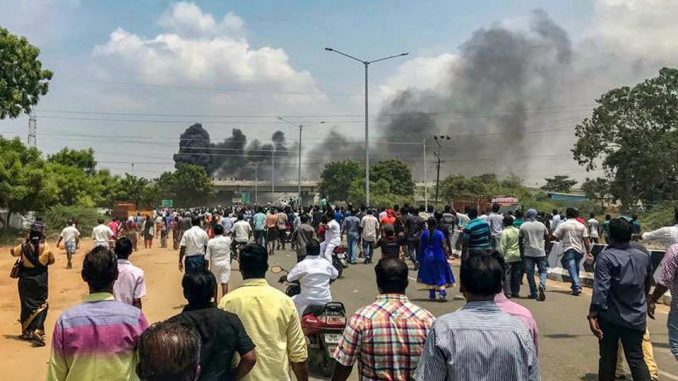
By Soumya Sarkar
A look at the list of conflicts indicates a cosy relationship between business and political interests, supported by a compliant administration
The Tamil Nadu government has finally closed down a copper smelter owned by Vedanta Resources in Thoothukudi, a week after police gunned down 13 protesters who had taken to the streets against a proposed expansion of the factory. They said it was poisoning the air they breathe and the water they drink. Had the authorities shown alacrity in listening to them, these lives could have been saved and thousands of others would have been spared serious health problems caused by the fouled air and water in the plant’s vicinity.
The shooting on May 22 once again shone a spotlight on India’s terrible record of dealing with environmental conflicts, with the administration often directing its firepower on behalf of offending corporations rather than the people. The Thoothukudi shooting was reminiscent of another such killing on January 2, 2006, at Kalinganagar in coastal Odisha, when police opened fire on tribal people protesting the setting up of a steel plant by the Tata Group, and killed 13.
The deaths at Thoothukudi may have downed shutters of the Vedanta factory for now, but the tribal deaths at Kalinganagar failed to stop Tata Steel, which has since commissioned its plant. More than 12 years after the Kalinganagar incident, an inquiry commission found no fault with the authorities. What stands out from the two similar incidents is that, whatever the outcome of civil protests, lives of citizens are cheap and neither the state nor corporations are willing to own up to the cost of harming and degrading the environment.
Cosying interests
India has the dubious distinction of more environmental conflicts than any other country, according to Environmental Justice Atlas, an international database. At last count, the atlas lists 271 cases in India, far ahead of Colombia’s 128, the second-worst nation. Even a cursory look at the list of conflicts indicates a cosy relationship between business and political interests, supported by a compliant administration.
Repeat offenders
What else could explain, for instance, the continuing operation of scores of Coca-Cola bottling plants despite widespread civic opposition in places ranging from Uttarakhand and Uttar Pradesh in the north to Kerala in the south?
The global soda conglomerate has been repeatedly accused of abusing local water resources, depleting groundwater levels, and contaminating the soil. Strong protests have shuttered a couple, but scores of others continue, with no indication that the company has taken strong steps to address the environmental damage it causes.
Unfortunately, there are hundreds of such instances of abuse, and only a handful receive any attention, and that too only when the local community protests.
For some, the narrative of conflicts is seen as development versus environment. It is patently a false binary because there is enough evidence that economic prosperity does not necessarily mean environmental degradation.
In fact, a few opinion makers have the gall to claim that these conflicts stifle the ease of doing business in the country. Such a blinkered view ignores the fact that the growth of business and rapid industrialisation is but a means to provide for a better life for the people of the country. If the happiness and well-being of citizens are compromised and their natural environments are poisoned to fill state coffers and line the pockets of big business, what use does society have for such growth?
Daylight murder
One way authorities have tried to address environmental concerns is to frame more stringent laws to conserve natural resources, limit the environmental impacts of industrialisation, and offer some compensation to people who have borne the brunt of so-called development. But it is a bitter truth that lawmaking in India is often an opportunity to open up loopholes that enable authorities and businesses to flout norms, and sometimes, literally get away with murder.
This is evident when we find that India is ranked 177 among 180 nations on the Environmental Performance Index 2018, dropping precipitously from 141 in 2016, according to the biennial report by Yale and Columbia universities along with the World Economic Forum.
It is at the bottom of the heap on environmental health and third-worst in the world on air quality.
Researchers have consistently found that environmental governance in India is poor not because of laws but their pathetic implementation, particularly because the framework does not allow for meaningful public participation, resulting in imprudent resource management. Experts such as A. Damodaran of Indian Institute of Science have for long argued for a multi-layered environmental governance system that is based on locally prepared and implemented plans that blend conservation goals with sustainable development instead of formulation centrally designed rules on the false one size-fits-all premise.
In a scenario when environmental governance has clearly failed, the judiciary has picked up the slack. The courts have often batted for environmental causes and have been more sympathetic of community concerns than the administration. But they have a tough job ahead. There were 21,145 environmental cases pending for trial in 2016, according to an analysis in the State of India’s Environment 2018, which will be released by the Centre for Science and Environment on World Environment Day on June 5.
Till environmental justice is seen to be delivered, one thing is crystal clear:. public opinion demands that the killing of environmental protesters must stop.
Source: The Hindu

Leave a Reply